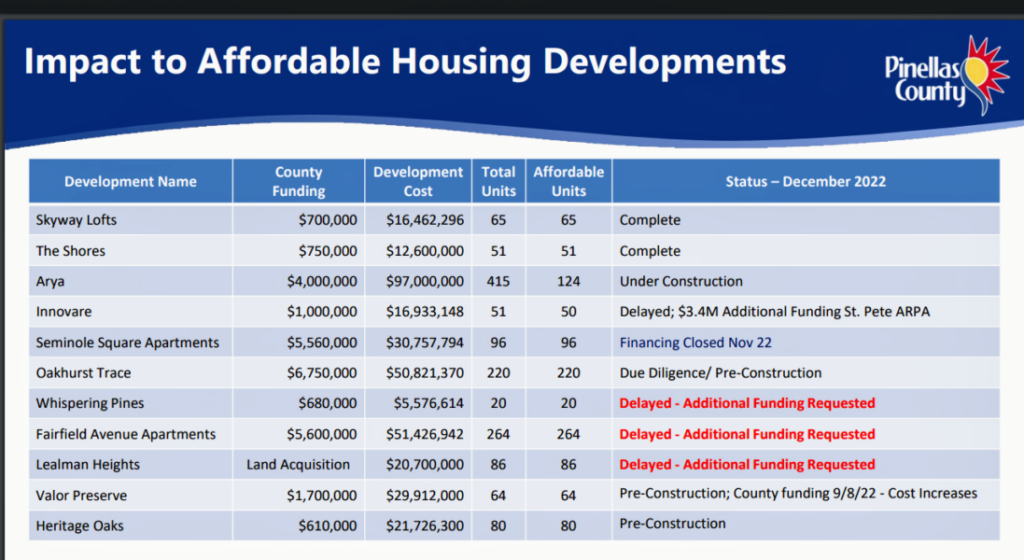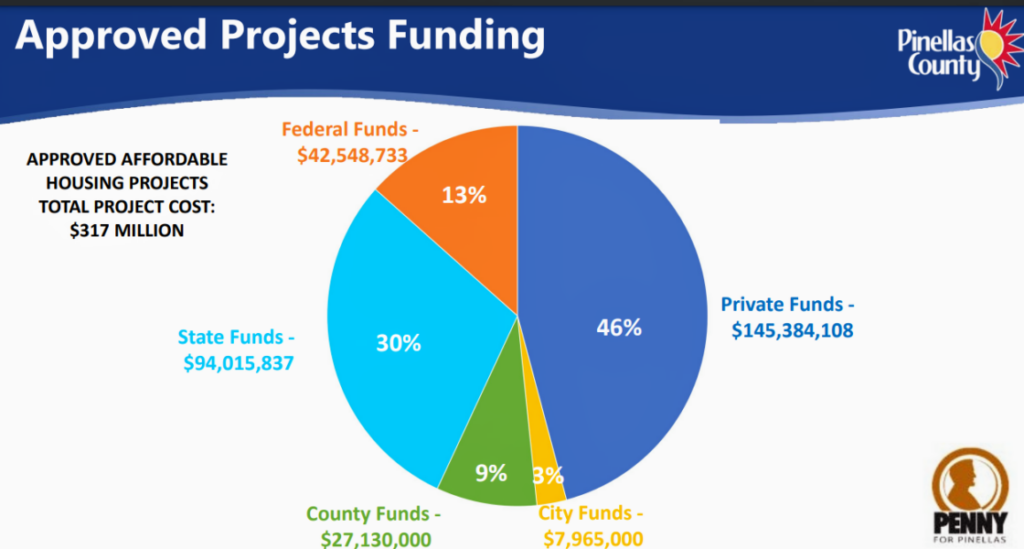Thrive
Soaring costs delay affordable housing projects

Local officials continue grappling with cost increases impeding the construction of affordable housing developments, with at least five now delayed due to additional funding requests.
During Thursday’s Pinellas County work session, Administrator Barry Burton told commissioners that construction costs for some affordable housing projects have recently doubled. He said developers asking for more funding is now a common occurrence and will likely lead to some tough decisions.
“The costs have skyrocketed,” said Burton. “It’s a challenge – at what point do we say, ‘it’s too much government subsidy for the project to go forward.'”

A graphic highlighting affordable housing delays due to soaring costs. Screengrab.
St. Petersburg is home to three of the five projects delayed due to funding requests. One is in Lealman, and the other is in Seminole. Together, developers asked for an additional $5.2 million from city and county coffers to provide 156 affordable units.
Notably, the Fairfield Avenue Apartments in St. Pete are among the pending projects. City officials received widespread acclaim for becoming the first to utilize House Bill 1339, which allows municipalities to transform industrially zoned properties into affordable housing expeditiously.
The city council unanimously approved reallocating $2.28 million in American Rescue Plan Act (ARPA) money to fund the initial construction of the Fairfield Apartments, formerly a lumber site, in August. According to county documents, the total development cost is $51.4 million for 264 units, with 120 reserved for those making under 80% of the area median income (AMI) and 144 capped at 120%.
Commissioners previously agreed to use $5.6 million in Penny for Pinellas sales tax funding for the project, providing $3 million at closing and $2.6 million as the developer reaches affordability milestones. However, Bruce Bussey, community development manager, told commissioners Thursday there is a $5-$7 million funding gap in Fairfield’s latest construction bid.
“That concept (HB1339), in terms of where you can do it, is great,” said Bussey. “But it still doesn’t necessarily cover the cost.”
Bussey added that the developer is in talks with city and county officials. He said he would bring the matter back to the board once his municipal counterparts decide how much additional funding they can commit.
Commissioner Dave Eggers expressed that long-term expenses associated with people moving out of the area and a continuing workforce shortage could outweigh the increase in construction costs – about 30% over the last three years.
“If you talk to our business owners, our hotels and our governments, we’re all running at about 80 to 90% (staffing),” said Eggers. “I’m not all for helping these developers out, but the reality is … they got to be able to turn some money, some positive gain.”
Burton explained that county administrators have hoped to provide $30-$40,000 in subsidies per affordable unit. He said that number is now over $70,000 for some projects.
While he realizes the private sector cannot foot the entire bill and still move forward with the development, Burton said costs almost doubling creates the need for conversations regarding public funding comfort levels.

A graphic showing affordable housing funding sources. Screengrab.
The school district is converting some of its properties into workforce housing, Eggers noted, and two major league baseball organizations are also building apartments for employees.
“I think the business piece of that is going to have to be part of the solution,” said Eggers. “They’re the ones that are hurting as badly as anyone else.”
Bussey relayed that the current project cost for approved affordable housing projects is $317 million. State and federal grants make up 43% of the total, with the private sector contributing 46%.
County and city funding comprise the remaining 12%, with Pinellas coffers providing $27.1 million and municipalities offering $7.97 million. Bussey called the county’s land trust program, which allows officials to maintain affordable rates in perpetuity, a “cutting-edge aspect that most jurisdictions do not have.”
Despite those funding sources, Bussey said available land is in short supply. Additionally, operational, insurance and financing costs have also soared.
Using a development formerly slated for Central Avenue in St. Petersburg as an example, Bussey said local officials have “lost a project or two” due to developers seeking a better return through market-rate rentals, despite the subsidies. While he expects to hear complaints from residents, Burton said the only way to lower project costs is through density bonuses and similar measures.
“Because otherwise, you’re going to run out of money from out of the Penny real quick,” he added. “It’s not one size. We got to hit all these different areas, not just the people that are traditionally affordable housing builders.”
Bussey said his department would continue working with developers to discern how to mitigate soaring costs. He added that he would ensure all stakeholders share the associated “pain” and – despite coming with more strings attached – maximize state and federal funding.








Leslie Taylor
May 14, 2023at7:34 am
My daughter a LPN , a nurse and working for the same company for the past 10 years . Raising 2 kids on her own ,going back to school. Makes only about 22 dollars and hour. Can only afford to Rent a not very good apartment, in a ghetto environment. In north St Petersburg. She has seen in increase in the homeless . Please define “affordable “ . What is affordable for one family / person is not affordable for another. After she graduates from Nursing school ( getting her RN ) her kids will b graduating from High School . This will happen in about a year . She will not b able to “afford” to rent a better apartment in a non ghetto environment. Will b forced to move out of Pinellas county and maybe the entire state of Florida. Florida/ St Pete will b losing a professional, an RN which is desperately needed. Florida is fast becoming only for the “affordable “ so please define “affordable “. Thx u
Nicole Caron
December 14, 2022at6:43 pm
“the private sector cannot foot the entire bill” – That’s funny. The private sector has no trouble footing the entire bill for all of the luxury apartments and condos all over downtown. The people who move here, buy those units, and expect retail, restaurant and entertainment service may be surprised to find that workforce very reduced because workers can’t afford to live here.
Brent Everett
December 14, 2022at9:51 am
Well written, informative and covered the bases. Those factors that are impacting the costs are difficult to mitigate and work around.
Mike
December 14, 2022at9:18 am
So the “affordable housing” project is actually not affordable?? I’m shocked! Shocked I tell you!
This is the single most unbelievable thing I’ve ever heard of! I am gobsmacked that a government housing project labelled as “affordable” turns out to be unaffordable!
What’s next?!?!?